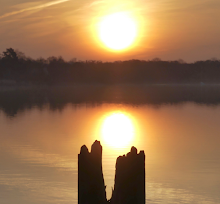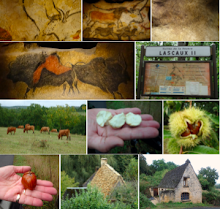Yesterday was a long day with fantastic experiences. We got an early start although it was yet another wet and cool morning. After an improvised 25-km long shortcut through the lush but quite uninhabited landscape we reached the valley of the river La Vézère. This piece of France has the richest abundance of prehistoric sites, shelters and caves once occupied by Neanderthals and later by Cro-Magnon humans.
The most famous of the caves is Lascaux, discovered in 1940 and closed again in 1963. We were, however, fortunate to become part of a guided tour in Lascaux 2, an underground exact replica of the original cave, – and that was an extraordinary experience!
18,600 years-old paintings all over the cave walls and ceiling!!
Horses and aurochs were the species most commonly depicted.
The paintings were in black, brown, red, orange and yellow nuances using pigments mixed from ochre-rich soils and biotite from local manganese-rich rocks. The application techniques included using fingers, spitting, blowpipe and moss dubbing. The largest animal on the wall was a 6-meter long aurochs, the smallest was a hand-size deer.
We spent almost 90 minutes in the cool and very dark cave, that was lit only by small torches. My Sony camera was challenged by the no-flash, high-ISO and no-tripod condition but did well.
 |
| Two bison bulls. |
Seeing this magnificent art created by some of my ancient ancestors was a lifetime experience for me, who spent years of my own life living with and watching large animals in wild landscapes.
During the cave visit, the aboveground weather had improved considerably. We checked out the nearby town of Montignac on La Vézère and then turned our wheels southwards along the left bank of the river.
Château de Losse is just one of many pleasant sights along the Vézère river ...
... another one is the village of Saint Léon where we stopped for a refreshment.
Farther along the river, we came upon a very special kind of habitation:
A "city" of troglodytes. This society of cave people lived in seclusion high above the river in the hollowed out north face of La Roque Saint Christophe.
For about 1 km the whole rock face actually looks like a Swiss cheese with holes everywhere.
80 meters above ground the main living quarters once provided a safe heaven for people in times of peril.
Late in the afternoon we passed these good-tempered geese patiently waiting to provide their body parts to the French cuisine.
Finally, after 60 km of pedalling we reached our destination:
Les Eyzies-de-Tayac-Sireuil, aka Les Eyzies.
A village situated between two rivers and partly built into the sheer rock face.
We reside in Hôtel de France with this magnificent view:
Today, Tuesday 19 September is reserved for exploring the prehistoric sites around the town while enjoying the delightful ambiance.







































